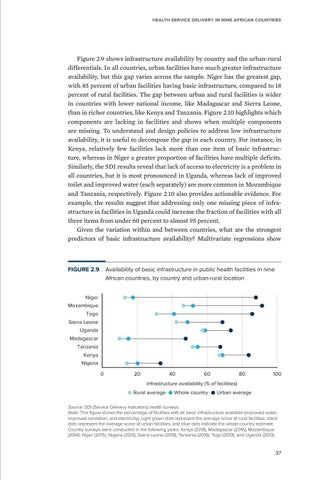Health service delivery in nine African countries
Figure 2.9 shows infrastructure availability by country and the urban-rural differentials. In all countries, urban facilities have much greater infrastructure availability, but this gap varies across the sample. Niger has the greatest gap, with 85 percent of urban facilities having basic infrastructure, compared to 18 percent of rural facilities. The gap between urban and rural facilities is wider in countries with lower national income, like Madagascar and Sierra Leone, than in richer countries, like Kenya and Tanzania. Figure 2.10 highlights which components are lacking in facilities and shows when multiple components are missing. To understand and design policies to address low infrastructure availability, it is useful to decompose the gap in each country. For instance, in Kenya, relatively few facilities lack more than one item of basic infrastructure, whereas in Niger a greater proportion of facilities have multiple deficits. Similarly, the SDI results reveal that lack of access to electricity is a problem in all countries, but it is most pronounced in Uganda, whereas lack of improved toilet and improved water (each separately) are more common in Mozambique and Tanzania, respectively. Figure 2.10 also provides actionable evidence. For example, the results suggest that addressing only one missing piece of infrastructure in facilities in Uganda could increase the fraction of facilities with all three items from under 60 percent to almost 95 percent. Given the variation within and between countries, what are the strongest predictors of basic infrastructure availability? Multivariate regressions show
FIGURE 2.9 Availability of basic infrastructure in public health facilities in nine African countries, by country and urban-rural location Niger Mozambique Togo Sierra Leone Uganda Madagascar Tanzania Kenya Nigeria 0
20
40
60
80
100
Infrastructure availability (% of facilities) Rural average
Whole country
Urban average
Source: SDI (Service Delivery Indicators) health surveys. Note: This figure shows the percentage of facilities with all basic infrastructure available (improved water, improved sanitation, and electricity). Light green dots represent the average score at rural facilities, black dots represent the average score at urban facilities, and blue dots indicate the whole-country estimate. Country surveys were conducted in the following years: Kenya (2018), Madagascar (2016), Mozambique (2014), Niger (2015), Nigeria (2013), Sierra Leone (2018), Tanzania (2016), Togo (2013), and Uganda (2013).
37


